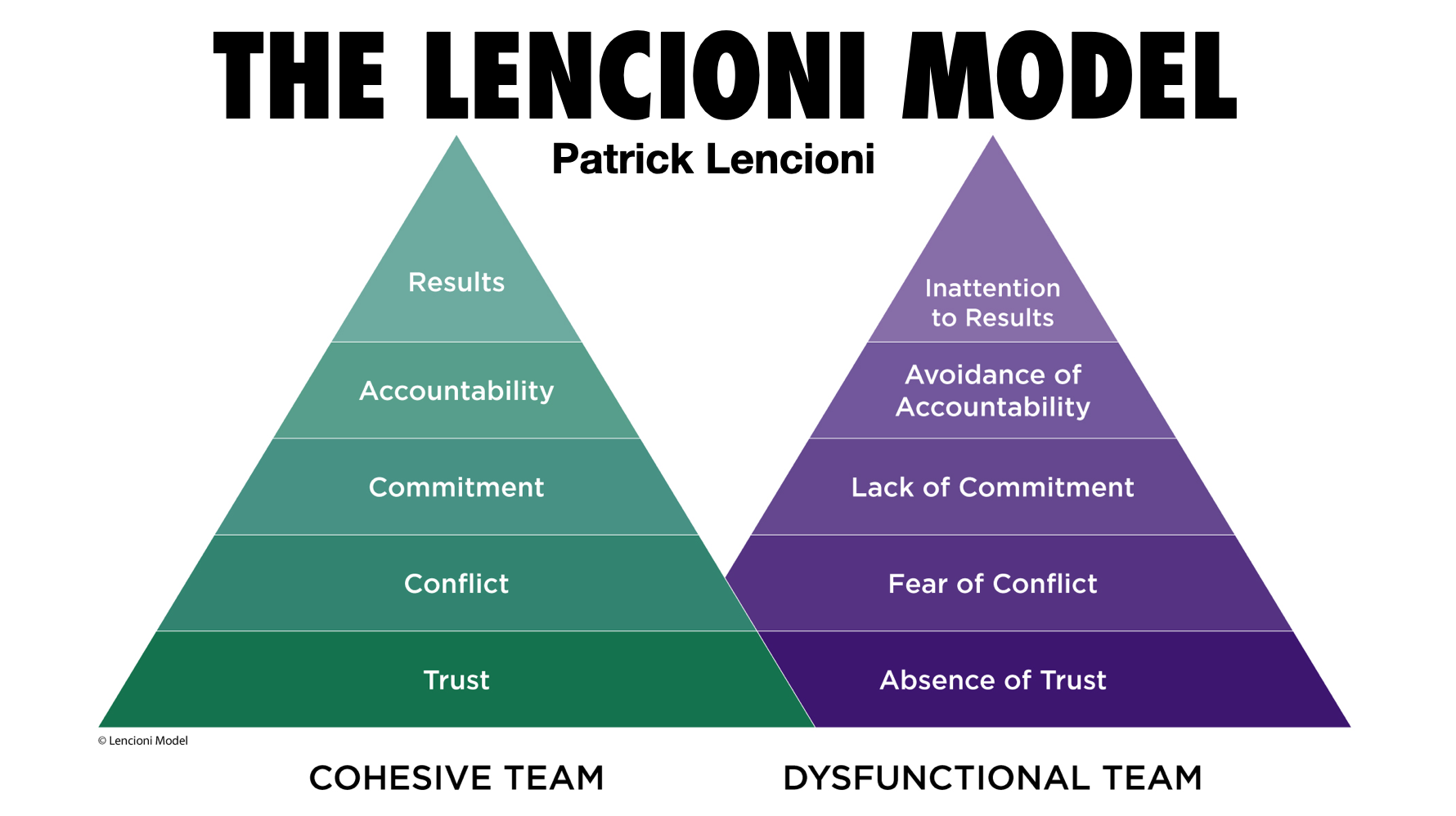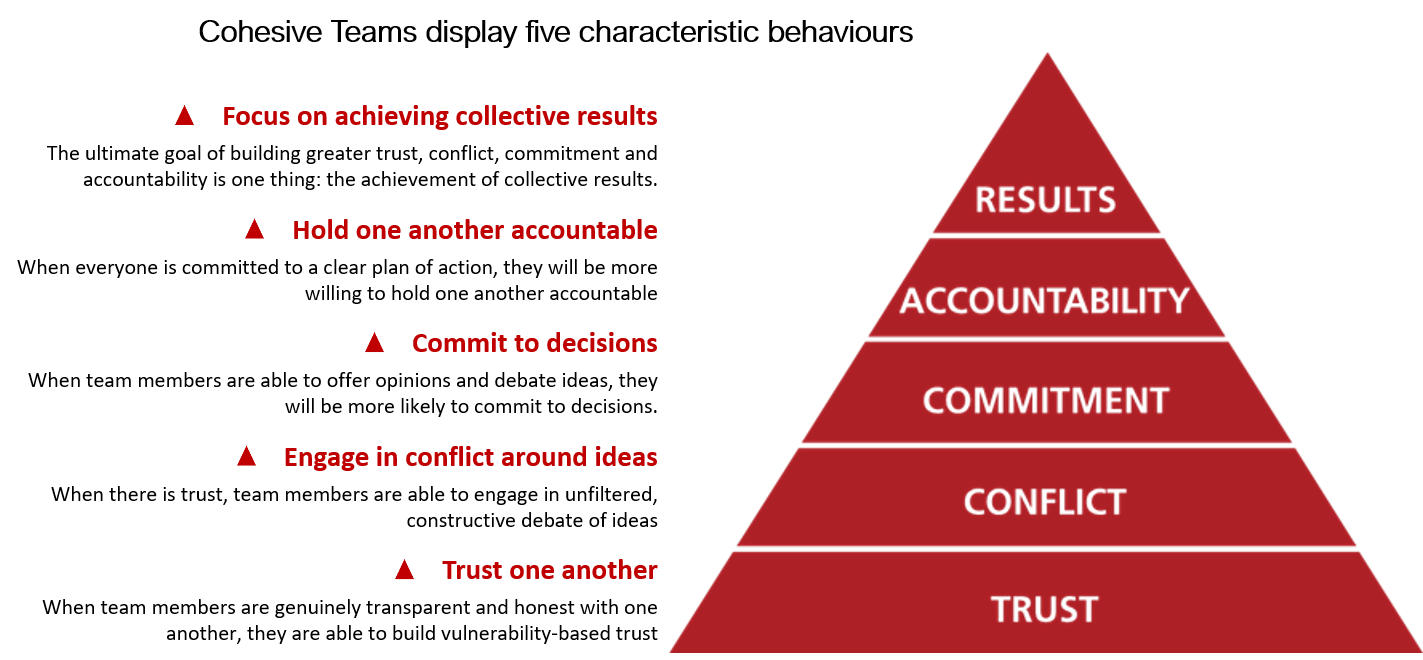Debugging teams with the Lencioni Model
November 12, 2022
Introduction
Team effective models give you a framework to better debug and understand what’s working (or isn’t) on your team and how you can empower their best work. In this write-up we’ll cover one popular team effectiveness framework, The Lencioni Model.
The Lencioni model is a framework for diagnosing and treating dysfunction within an organization. It was first published in 2002 in a book called “The Five Dysfunctions of a Team,” by Patrick Lencioni which became a New York Times best seller.
Lencioni used the model to describe five main problems that plague an organization if they are not addressed properly: Trust, Conflict, Commitment, Accountability and Results. A brief video on the model is also available.
What does the Lencioni model look like?
The Lencioni model is structured like a pyramid, with trust at the bottom of the pyramid and inattention to results at the top. The other dysfunctions build on top of each other as you go up the pyramid.

The Five Dysfunctions of a Team are:
- Absence of trust: If your team doesn’t trust you, or each other, they won’t do their best work
- Fear of conflict: Healthy, constructive conflict is a necessity to live up to their full potential.
- Lack of commitment: Good work takes commitment - without it can bring the rest of the team down.
- Avoidance of accountability: if there’s no accountability, there’s no success.
- Inattention to results: If not focused on their collective goals, they’ll never hit them. One way to do this by providing a step-by-step approach for identifying and resolving issues in your organization. If you try to skip steps or ignore any parts of the process, there’s a good chance that your attempts at addressing team dysfunction may fall short.
If you’re a manager, don’t rush to fix team dysfunction. Be sure to identify the problem and all of its causes before trying to address it.
Absence of Trust
When trust is absent among team members, they are unable to be vulnerable with one another or show weakness. As a result, people will not admit mistakes and seek help from others.
Fear of Conflict
When a team lacks trust, its members fear conflict and keep quiet during debates. This results in poorer decisions than if their opinions had been voiced openly.
Lack of Commitment
Fear of conflict leads to indecision and poor cohesion among team members. As a result, there is little commitment to decisions, which creates an environment where ambiguity prevails.
Avoidance of Accountability
A lack of commitment leads to a breakdown in accountability among team members. If one has not bought into the decision, they will be less likely hold peers accountable for their actions.
Inattention to Results
If team members don’t feel accountable for their actions and goals, they tend to put the needs of individuals above those of the group. This can lead to miscommunication within teams as well as a decline in company performance overall.
Debugging Dysfunctions
Dysfunctions such as power struggles and lack of trust between team members are common in many organizations. According to Lencioni, overcoming the absence of trust requires the team to show vulnerability and the willingness to take risks.

Leadership should acknowledge these dysfunctions, seek to understand their root causes, and then work together with other leaders on a plan for addressing them—that will result in more productive teams.
Here are some simple questions to ask yourself in order to determine the level of dysfunction within your organization:
- Does your team feel comfortable expressing their opinions?
- Do people dread or enjoy your team meetings?
- Is the team able to come to decisions quickly and avoid getting stuck in endless debate?
- Do team members hold one another accountable for their actions and behavior?
- Does the team prioritize the common good over individual interests?
To be a successful leader, you must model trust and openness. Encourage disagreement in productive ways. Be clear about roles and responsibilities. Set the bar high but realistic—and celebrate when team members surpass those standards!
Pros and Cons of the Lencioni model
The Lencioni model is a great tool for identifying what’s going on in your
organization. It can also be helpful for pinpointing the root cause of problems
that are holding you back from reaching your goals and achieving success.
The Lencioni model is useful for a number of reasons:
- It’s a great way to identify the root cause of team dysfunction. You can then take steps to address that issue and others that may contribute to it.
- It’s a good tool for drawing attention to the importance of focusing on your organization’s goals. If not focused on their collective goals, they’ll never hit them.
- The model can be a helpful way to identify how you and your team can work together more effectively. If there’s a gap between where you are now and where you want to be, it’s important to address that issue head on.
The downside to high-performance team models like Lencioni’s is that they aren’t as prescriptive as they could be. You’ll likely need to choose the model you think works best and then tweak it as needed or change your approach entirely down the road. Lencioni’s model also relies on the ability of team members to be vulnerable in order to progress toward trust.
Conclusion

The Lencioni model is a helpful tool for leaders who want to build strong teams. It provides a framework for assessing how your team is functioning and identifying areas where improvement is needed. But it’s important not to skip over any steps when working on team dysfunction; instead, take care of all necessary steps so that you can develop a successful team.
Note: If you’re interested in learning more from Pat, I am also happy to recommend “The Ideal Team Player” book: in it, Pat makes the case that the key to success in an increasingly team-oriented world is being humble, hungry and smart. He also covers this in his TED talk.